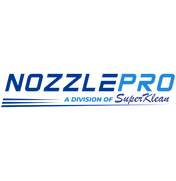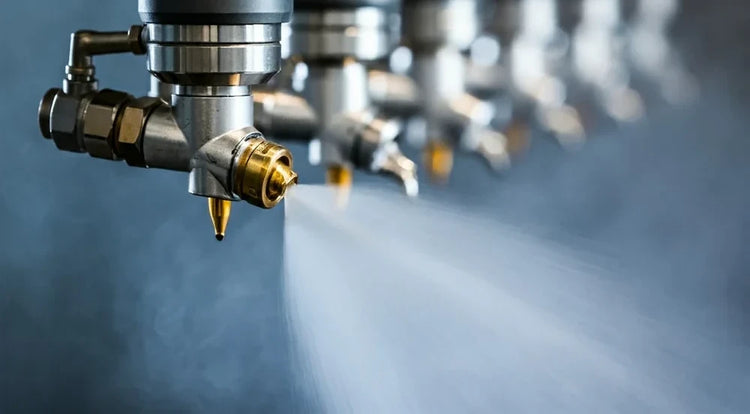Durable Spray Nozzles for Industrial Safety
Fire Protection & Safety Spray Nozzles
NozzlePro fire protection and safety nozzles are engineered for industrial applications requiring reliable water spray performance in high-temperature and demanding environments. From equipment cooling to dust suppression and emergency water curtains, our nozzles deliver consistent spray patterns for facility protection and worker safety.
Applications for Fire Protection & Safety
Fire protection spray nozzles are used in industrial facilities for various safety-related applications. While certified fire suppression systems require agency testing and approval, NozzlePro offers durable spray nozzles suitable for non-certified fire safety applications:
Equipment Cooling
Cool hot equipment, machinery, and process vessels using water spray to reduce temperatures and prevent thermal damage during normal operation or emergency shutdown.
Dust & Particulate Control
Suppress dust clouds and airborne particulates in grain handling, woodworking, mining, and powder operations improving air quality and reducing combustible dust risks.
Emergency Water Curtains
Create water spray barriers for emergency situations and hazard isolation using manual hose systems or fixed spray arrays for temporary fire safety.
Facility Washdown & Cleaning
Use high-flow spray nozzles for routine facility cleaning, equipment washing, and site decontamination supporting operational safety and hygiene.
Important: Certified vs. Non-Certified Fire Protection
True fire suppression systems designed to protect high-value assets, critical equipment, or hazardous processes require certification by agencies such as UL (Underwriters Laboratories) or other recognized testing organizations. Each nozzle size and configuration must undergo agency testing to verify performance specifications (flow rate, spray pattern, reliability) and meet applicable fire protection codes (NFPA standards).
NozzlePro offers fire protection and safety spray nozzles suitable for non-certified applications such as equipment cooling, dust suppression, emergency water spray, and general industrial safety. These nozzles provide reliable water spray performance in demanding industrial environments but are not tested and certified for compliance with fire suppression system standards.
If your application requires a certified fire suppression system protecting critical assets, hazardous materials, or insurance-required protection, you must work with a professional fire protection engineer and specify only certified nozzles from manufacturers with appropriate agency approvals (UL, FM, etc.).
Spray Nozzle Types for Fire Safety Applications
Different nozzle designs suit different safety applications. Here are common types used in fire protection and industrial safety:
Full Cone Spray Nozzles
Deliver 360-degree uniform spray patterns ideal for cooling equipment, creating water curtains, and general cooling applications. Available in 30° to 180° spray angles with flow rates from 1–50 GPM at standard industrial pressures (40–150 PSI).
Hollow Cone Spray Nozzles
Create ring patterns with concentrated impact useful for dust suppression and mist generation. Effective for long-range spray and fine mist applications requiring better penetration than full cone patterns.
Flat Fan Spray Nozzles
Produce rectangular spray patterns ideal for washdown, surface cooling, and area coverage. Excellent for directing water to specific equipment or facilities needing targeted spray coverage.
High-Flow Nozzles
Deliver large volumes of water (50–500 GPM) for rapid cooling, facility protection, and emergency water spray applications. Built for durability and reliability under demanding industrial conditions.
Durable Materials for Harsh Environments
Fire protection and safety applications often involve high temperatures, corrosive chemicals, and demanding conditions. NozzlePro offers nozzles in multiple material options:
Brass Construction
Standard material for general industrial applications. Corrosion resistant and cost-effective for most water spray uses including cooling and dust suppression.
Stainless Steel (316)
Superior corrosion resistance for harsh, corrosive, or marine environments. Ideal for facilities with chemical exposure, saltwater environments, or extreme durability requirements.
Polymer Construction
Lightweight, cost-effective option for certain applications. Resistant to specific chemicals and suitable for lower-pressure spray systems.
Ductile Iron
Heavy-duty construction for high-pressure applications and industrial equipment. Provides strength and durability for demanding cooling and washdown systems.
Industries Using Fire Safety Spray Nozzles
NozzlePro fire protection and safety nozzles serve various industrial sectors:
- Manufacturing & Processing: Equipment cooling, dust control, facility washdown
- Agriculture & Food: Grain handling, flour mills, food processing dust suppression
- Mining & Aggregate: Dust suppression, equipment cooling, material handling washdown
- Woodworking & Lumber: Combustible dust control, facility safety spray systems
- Chemical Processing: Equipment cooling, facility safety washdown, emergency spray
- Power Generation: Cooling systems, dust control, equipment maintenance washdown
- Transportation & Logistics: Facility washdown, equipment cooling, general safety spray
Why Choose NozzlePro Fire Safety Nozzles
Reliable Performance
Engineered for consistent spray patterns and reliable operation in industrial environments.
Multiple Material Options
Brass, stainless steel, and durable polymers for different environmental conditions.
Wide Range of Flows
From precise mist to high-volume spray (1–500 GPM) for any industrial safety application.
Cost Effective
Professional quality fire safety nozzles at reasonable pricing for industrial applications.
Easy Integration
Standard NPT connections, simple installation, and straightforward maintenance.
Technical Support
Expert guidance selecting the right nozzle type, material, and configuration for your application.
Fire Safety Spray Nozzle FAQs
What's the difference between certified and non-certified fire nozzles?
Certified fire suppression nozzles are tested and approved by agencies (UL, FM, etc.) for specific applications protecting critical assets. Non-certified fire safety nozzles are suitable for general industrial applications like cooling and dust control but don't carry suppression system approvals.
Do I need certified nozzles for my application?
If your system protects high-value equipment, hazardous materials, or is required by insurance or code to be a certified fire suppression system, yes—you need agency-approved nozzles and professional fire protection engineering. For general industrial safety applications (cooling, dust control, emergency spray), non-certified nozzles may be appropriate.
What materials work best for high-temperature applications?
Stainless steel (316) provides superior corrosion resistance and durability in high-temperature and harsh chemical environments. Brass is suitable for standard industrial applications. Discuss specific environmental conditions with our team to select optimal materials.
How do I select the right flow rate for cooling?
Equipment cooling typically requires 0.15–0.50 GPM per square foot of surface area, depending on heat load and desired cooling rate. Dust suppression uses lighter misting (0.05–0.15 GPM/sq ft). Emergency water spray varies by application. Contact our team with equipment specifications and we'll recommend appropriate flow rates and nozzle types.
What maintenance do fire safety nozzles require?
Regular inspection for clogging, corrosion, or physical damage ensures reliable operation. Flush nozzles periodically with clean water. For corrosive or hard-water environments, more frequent maintenance may be needed. Replace nozzles showing significant wear or flow changes.
Can NozzlePro help design a fire safety system?
We provide technical support selecting appropriate nozzle types, materials, and configurations for your application. For certified fire suppression systems requiring professional engineering and code compliance, you'll need to work with a licensed fire protection engineer.
Select the Right Fire Safety Nozzles
Contact NozzlePro to discuss your fire protection and safety application. Our team will help you select appropriate nozzle types, materials, and configurations for reliable industrial performance.

